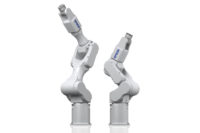See It at the Show
New Delta Robot Designed for High-Speed Applications

Available with two to five axes of motion, the DR series delta robots are designed for high-speed assembly and handling.
Photo courtesy WEISS North America Inc.
With their spindly arms and fast motion, delta robots resemble spiders. Each arm is driven by a motor mounted in a stationary base above a large cylindrical work envelope. The arm joints work together to drive a rotary axis connected to an end-effector.
Jointed in the middle, the arms bend inward and connect with a small tooling plate to which the end-effector is attached. Coordinated movement of the forearms up or down pushes the elbows inward or outward, which move the plate in the X, Y and Z axes. As the robot moves up and down and side to side, the tooling plate remains parallel with the work surface.
With delta robots, all the motors are in a stationary location on the mechanism. Unlike other types of robots, the mechanism does not carry around the weight of the motors. And, the robots operate in an obstruction-free work envelope.
That, combined with components made out of lightweight materials, such as aluminum and carbon-fiber composites, provides a very low inertia system. This type of mechanical design enables delta robots to perform at high-speeds.
The machines were originally designed for low-payload applications, such as pick-and-place operations. But, they can also be used for some assembly applications, such as adhesive dispensing, labeling, screwdriving and soldering.
One of the newest delta robots was recently introduced by WEISS North America Inc., a provider of rotary indexing tables, linear transfer systems, pick-and-place devices, trunnions and other automation components.
Available with two to five axes of motion, the DR series delta robots are designed for high-speed assembly and handling—especially for automated applications in the packaging and electronics industries. In these applications, they offer high speed and precision. With their own preconfigured controller, the delta robots can immediately be put into operation and integrated, without any in-depth knowledge of programming.
Multiple models are available to carry nominal loads from 0.5 to 350 kilograms. Work envelopes range from 200 to 2,000 millimeters. The robot can perform up to 240 standard cycles per minute. All control components can be integrated into the system control.
For more information on delta robots, indexers and other automation components, click www.weiss-world.com or visit the company’s booth at The ASSEMBLY Show. Weiss is of many suppliers of plastics assembly equipment that will be exhibiting at the show, which will take place Oct. 22-24 at the Donald E. Stephens Convention Center in Rosemont, IL. Besides plastics assembly equipment, you’ll find 250 suppliers of robots, automation, motion control technology, parts feeders, fastening tools, software and other assembly technologies. For more information, visit www.theassemblyshow.com.
Looking for a reprint of this article?
From high-res PDFs to custom plaques, order your copy today!






